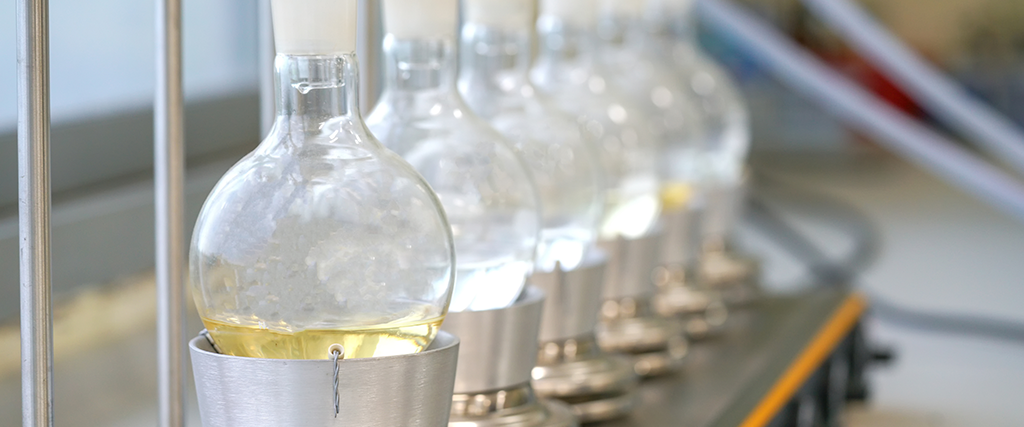
Production of Essential Oils
There are several methods to obtain essential oils. The most commonly used is steam distillation. But other methods are also common. Here you can learn more about common methods such as cold pressing, extraction, CO2 extraction and enfleurage.
STEAM DISTILLATION
The basic principle of distillation is simple: water is evaporated and immediately cooled down again, i.e. condensed. However, the extraction of essential oils requires so much intuition and know-how about the right pressure, the right temperature and the length of the whole process that one can rightly speak of an art (of craftsmanship).In an upwardly tapering container (alambic), the plant material is placed on a sieve under which there is boiling (well) water. Due to the heat and the resulting pressure, the water vapor mechanically pulls the tiny scent molecules up with it (piggyback process). In a cooling coil, the steam that has risen is immediately cooled, it condenses. This condensed water, called hydrolate, together with the essential oil, which due to its low density is mostly deposited on the surface, goes into a second container (Florentine vase), from where both can be taken with "water chickens" placed at the appropriate height. However, there are also essential oils that are heavier than water and therefore sink to the bottom. The "water chicken" is then located quite far down on the Florentine vase.
The essential oil is filtered and bottled in glass jars. It must now be aerated for a few days, i.e., stored without a cap, and then rest in a cool, well-ventilated cellar so that it can develop its characteristic fragrance properties.
Temperature and pressure must be very carefully monitored during the distillation process, an experienced distiller knows the characteristics of processing the different types of plants. In general, it can be said that the temperature should not exceed 100 degrees Celsius, the pressure should be only slightly above atmospheric pressure. The distillation time always extends to over an hour, it can last up to 100 hours as in the case of sandalwood.
COLD PRESSURE
This very gentle process is used exclusively for the extraction of agrumen oils (citrus peel oils)from the peels of the citrus fruits orange, bergamot, mandarin, grapefruit, lemon, lime (the latter is sometimes distilled). This "waste" from juice production is very sensitive to heat and is therefore squeezed mechanically. By destroying the outer layer of the fruit peel, the tiny oil containers are burst and the fragrance can be collected in containers.
To do this, the pulp and white skin must be carefully removed before pressing, leaving only the fine outer skin containing essential oil in clearly visible chambers. This is then simply pressed out either fresh, or sometimes in a dried state. In the case of top qualities, this is still done by hand pressing. Therefore, in good essential oils there is often a little sediment, or a slight fruit turbidity. You can easily try this process yourself for smallest quantities with a well-cleaned garlic press available in every household. However, be sure to use only unsprayed, unwaxed, and unvarnished fruit.
EXTRACTION
Some high-quality essential oils are obtained by extractions with a wide variety of solvents. The cheapest and, unfortunately, most commonly used method is solvent extraction with synthetic liquid hexane. In this process, in a closed vacuum system, hexane flows very slowly over the plant material placed on perforated plates, dissolving out the essential oils. At the end of the process, essential oil and hexane are separated again in a vacuum distillation. However, 5 to 30 ppm (parts per million) of the solvent cannot be removed, which corresponds to about one drop in a medium-sized swimming pool. The application of these "Absolue oils" dissolved with hexane in the aroma lamp or in the micro atomizer is completely problem-free. The great advantages of quality and healing effects in external use and in natural cosmetic preparations are highly present.
CO2 EXTRATION
Only recently, a small number of the highest quality, 100% pure essential oils obtained by CO2 extraction have been offered on the market. The CO2 used for extraction is the natural spring carbonic acid that occurs in large quantities in nature, a gas that is an essential, indispensable component in the overall cycle of natural processes and that everyone knows from sparkling mineral waters and sodas. If the bottle is closed, the CO2 present in the water is under pressure and thus remains liquid. If the bottle is opened, it can bubble out of the water. If the bottle or glass is left open for too long, the carbon dioxide evaporates after a short time. This process has been exploited. Carbonic acid pressurized in a closed system liquefies like other gases. Depending on the pressure and the resulting temperature, this liquid CO2 dissolves the volatile ingredients and active substances from the medicinal plants. Temperatures of maximum 40°C prevent denaturation of the sensitive essences. Incidentally, this is a temperature far below that required for distillation.
When the carbonic acid has finally done its duty, it leaves inconspicuously, without leaving the slightest trace of residue in the essential oil. There are not even exhaust air or waste water problems in the production process. The result is essential oils of incredibly good, pure quality.
ENFLEURAGE
To finish, we describe the oldest, most traditional natural, but unfortunately most expensive method of extracting essential oils, enfleurage. The production is done by hand, so it is very time-consuming and costly, which makes the essential oils almost priceless. Enfleurage involves scattering flower petals, for example, on glass plates covered with purified lard or beef fat. These glass plates are then placed on top of each other in large stacks. Over time, the fat absorbs the plant's fragrance and active ingredients. When the petals have wilted, they are removed and fresh ones are placed on top.
This process continues until the fat is saturated with fragrance and active ingredients and no longer absorbs anything. This takes up to three weeks, depending on the type of plant. After that, the fat is cleaned of all impurities. The product now created is called a pomade. This is now dissolved in alcohol by shaking for 24 hours. This causes the essential oil to dissolve from the carrier fat and can then be carefully skimmed off. A variation of this process is practiced with olive oil-soaked cotton muslin stretched on wooden frames.
The "absolues" obtained in this way are very highly concentrated and have very strong therapeutic power. Therefore, they are used very sparingly, in small quantities. One drop in the water bowl of an aroma lamp is quite enough to fill a whole room with fine fragrance. But also for use in natural cosmetics or ingestion, these essential oils are excellent.
